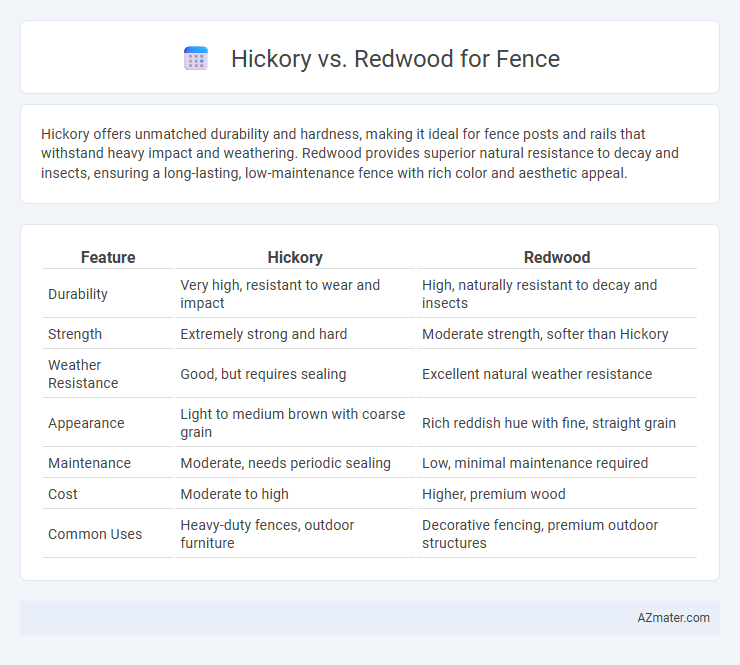Hickory offers unmatched durability and hardness, making it ideal for fence posts and rails that withstand heavy impact and weathering. Redwood provides superior natural resistance to decay and insects, ensuring a long-lasting, low-maintenance fence with rich color and aesthetic appeal.
Table of Comparison
| Feature | Hickory | Redwood |
|---|---|---|
| Durability | Very high, resistant to wear and impact | High, naturally resistant to decay and insects |
| Strength | Extremely strong and hard | Moderate strength, softer than Hickory |
| Weather Resistance | Good, but requires sealing | Excellent natural weather resistance |
| Appearance | Light to medium brown with coarse grain | Rich reddish hue with fine, straight grain |
| Maintenance | Moderate, needs periodic sealing | Low, minimal maintenance required |
| Cost | Moderate to high | Higher, premium wood |
| Common Uses | Heavy-duty fences, outdoor furniture | Decorative fencing, premium outdoor structures |
Introduction to Hickory and Redwood Fencing
Hickory fencing offers exceptional strength and durability due to its dense hardwood composition, making it ideal for high-impact and long-lasting fence structures. Redwood fencing provides natural resistance to decay and insects, along with rich reddish hues that enhance aesthetic appeal in outdoor settings. Both wood types balance functionality and beauty, with hickory emphasizing toughness and redwood highlighting weather resistance and visual warmth.
Wood Characteristics: Hickory vs Redwood
Hickory wood exhibits exceptional hardness and density, making it highly durable and resistant to impact, with a Janka hardness rating around 1820, significantly surpassing many common fence materials. Redwood is known for its natural resistance to decay and insect damage due to its high tannin content, combined with a softer texture and Janka hardness of approximately 560, offering easier workability but less impact resistance than hickory. For fencing, hickory provides superior strength and durability, while redwood delivers longevity and low maintenance through its natural preservative properties.
Durability and Longevity Comparison
Hickory fences exhibit remarkable durability due to their dense, hard grain, making them resistant to impact and wear, ideal for high-traffic areas. Redwood offers natural longevity with inherent resistance to decay, insects, and moisture, often lasting 20-30 years without treatment. When comparing durability and longevity, redwood generally outperforms hickory in outdoor fence applications because of its superior weather resistance and lower maintenance needs.
Weather Resistance and Maintenance Needs
Hickory wood offers moderate weather resistance but requires regular sealing to prevent moisture damage and maintain durability in outdoor fence applications. Redwood, known for its natural oils and tannins, provides superior weather resistance, resisting decay, insects, and warping with less frequent maintenance. Choosing redwood reduces long-term upkeep, making it ideal for fences exposed to harsh weather conditions.
Aesthetics: Color, Grain, and Visual Appeal
Hickory fences showcase a rich, golden-brown color with dramatic grain patterns that add rustic charm and strong visual texture to outdoor spaces. Redwood features a distinctive deep reddish hue with a fine, straight grain, providing a sleek and elegant appearance that enhances curb appeal. The choice between Hickory and Redwood hinges on desired aesthetics, with Hickory offering bold character and Redwood delivering timeless sophistication.
Cost and Availability of Materials
Hickory fences typically cost more due to the wood's density and durability, with material prices averaging $7 to $12 per square foot, but availability is limited mainly to specialty lumber suppliers. Redwood fences are generally more affordable, priced around $5 to $10 per square foot, and widely available across major home improvement stores and lumber yards in the western United States. Availability influences project timelines, as redwood's widespread accessibility reduces lead times compared to the often scarce and regionally sourced hickory lumber.
Environmental Impact and Sustainability
Hickory offers high durability and strength, making it a long-lasting fencing option that reduces the need for frequent replacements and minimizes resource consumption over time. Redwood is naturally resistant to decay and insects, which means it requires fewer chemical treatments and supports sustainable forestry practices when sourced from certified plantations. Choosing FSC-certified hickory or redwood ensures responsible harvesting that helps preserve ecosystems and promotes carbon sequestration through managed growth cycles.
Workability and Installation Ease
Hickory offers exceptional workability due to its density and flexibility, allowing for precise cuts and smooth finishes, making installation straightforward with standard woodworking tools. Redwood is softer and easier to machine, reducing installation time and effort, especially for DIY projects, while providing natural resistance to moisture and insects that enhances long-term durability. Both woods require pre-drilling for nails or screws, but redwood's lighter weight generally simplifies handling and positioning during fence construction.
Common Applications and Best Uses
Hickory is favored for fences requiring exceptional durability and resistance to impact, making it ideal for high-traffic areas and livestock enclosures. Redwood, known for its natural rot resistance and aesthetic appeal, is commonly used in decorative fencing and garden boundaries where visual impact is important. Both woods offer longevity, but hickory suits rugged, functional fences while redwood excels in enhancing landscape design.
Final Verdict: Choosing the Right Wood for Your Fence
Hickory offers exceptional durability and shock resistance, making it ideal for fences requiring strength and longevity, while Redwood provides natural resistance to decay and insect damage, ensuring low maintenance and a beautiful aesthetic. For budget-conscious projects prioritizing resistance to moisture and pests, Redwood is often the better choice, whereas Hickory suits high-impact environments needing robust structural integrity. Ultimately, selecting between Hickory and Redwood hinges on factors like climate exposure, maintenance willingness, and the desired fence lifespan.

Infographic: Hickory vs Redwood for Fence
 azmater.com
azmater.com